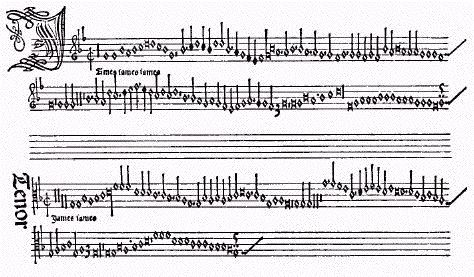Mensural Notation

The system of musical notation that was established c. 1250 by Franco
of Cologne and remained in use until 1600.
Notational signs fall into two classes; single notes and ligatures.
The single notes are:
maxima (Mx) longa
(L) breve (B)
semibreve (S)
minim (M)

Mensuration is the general term for the temporal relationships between
the note values, comparable to the different meters of the modern system.
Special terms are:
modus (the relationship between
L and B) tempus (between
B and S) prolatio
(between S and M)
In mensural notation the chief notes, namely L, B, and S, may equal either
two or three notes of the next smallest value. This dichotomy is
indicated by the terms "imperfect" or "perfect" and "major" or "minor."
Omitting the "modus" which is usually imperfect, there results four combinations
of tempus and prolatio, which constitute the four main mensurations of
mensural notations and are indicated by special signs.
